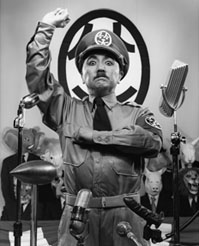 |
Focus features two in-depth reviews each month of fine art, architecture and design exhibitions and events at art museums, galleries and alternative spaces around Japan. The contributors are non-Japanese art critics living in Japan. |
|
|
 |
 |
 |
Double Takes
Christopher Stephens |
 |
 |
|
 |
| A Requiem: Asanuma 1, 1960.10.12-2006.4.2 (2006) |
|
A Requiem: Where Is the Dictator? 1 (2007)
|
Yasumasa Morimura has been quietly inserting himself into history for the last 25 years. By replacing central figures (and occasionally objects) with his own image in masterpieces of Western art by van Gogh and Manet, pinups of screen idols such as Marilyn Monroe and Audrey Hepburn, and documentary photographs of political leaders like Mao Zedong and Vladimir Lenin, Morimura (b. 1951) has created an alternative history of the world featuring himself in every role. The humorous touches and meticulous detail in his work are an immediate draw, but on a deeper level, Morimura raises a variety of questions related to our perceptions of culture and history.
His latest exhibition, A Requiem: Art on Top of the Battlefield, continues through April 10 at the Hyogo Prefectural Museum of Art, the last of a four-stop tour that began nearly a year ago in Tokyo. In this series, Morimura focuses primarily on military conflict, social upheaval, and political assassination in the 20th century, beginning with a set of pictures based on Eikoh Hosoe's fantastic depictions of Yukio Mishima and a video inspired by the novelist's final speech, delivered on the balcony of the Ichigaya headquarters of the Self-Defense Forces minutes before he took his own life in 1970. Rather than attempting to inspire a coup and restore the powers of the emperor, Morimura calls for the Japanese people to rise up in the name of art. But like the original plea, Morimura's harangue is ignored and eventually we find that the few people around are simply enjoying a day out in the park.
As with any adaptation of a historical event, Morimura's work sends the viewer back to the source to reexamine images that have long since lost their power through repeated use in the media. One look at the artist's restaging of the horrific 1968 execution of a Viet Cong soldier by a South Vietnamese police chief (captured by the Associated Press photographer Eddie Adams), and anyone familiar with Osaka will quickly notice that the row of low-rise buildings in the background has been replaced with the department stores that line Midosuji Boulevard in Shinsaibashi. The four men pictured (all portrayed by Morimura) are striking very similar poses and dressed in clothes that are nearly identical to those in the original, down to each wrinkle and rustle of fabric. This juxtaposition reminds us that events which now seem to occupy a distant historical and geographical remove could well have occurred just down the road. On the other hand, in Morimura's almost perfect recreation of the classic image of Albert Einstein sticking out his tongue (said to have been a weary reaction to constant attention from photographers on his 72nd birthday), there is a clearly visible line where the wig has been attached to the artist's forehead. This perhaps suggests that beneath the head of wild white hair associated so closely in our minds with scientific "genius," there was something more complex -- a real person.
Beyond the impressive quality of his images and the artist's amazing ability to transform himself into anyone, regardless of age, race, or gender, what is one to make of Morimura's work? Presumably, in the Requiem series, he is in some way delivering a blow against hate and war, and exhorting us to reassess our long-held beliefs regarding historical events -- but with a huge body of work in which the artist so relentlessly focuses on himself, it is sometimes difficult to detect Morimura's intent. Moreover, for anyone familiar with his work, the consistency of Morimura's approach has a way of discouraging a thorough consideration of individual photographs -- something one doesn't feel quite so keenly in the work of Cindy Sherman who, despite obvious parallels to Morimura, deals with types of characters and people rather than clearly identifiable faces.
Having said that, the Requiem exhibition is certainly engaging and provides a useful introduction to Morimura's work, especially when seen in conjunction with a selection of the artist's pieces from the museum collection that is running simultaneously through March 13. It is also notable for the inclusion of several video works interspersed between the photographs. In one, the 23-minute Gift of Sea: Raising a Flag on the Summit of the Battlefield, Morimura replaces the Stars and Stripes of military victory with a simple white sheet symbolizing a blank canvas to champion the ultimate human act of creation.
 |
|
 |
A Requiem: Remembrance Parade/1945, USA (2010)
|
|
Gift of Sea: Raising a Flag on the Summit of the Battlefield (2010)
All photos by Yasumasa Morimura, ©Yasumasa Morimura
|
|
 |
 |
Christopher Stephens
Christopher Stephens has lived in the Kansai region for close to 25 years. In addition to serving as the editor of the now defunct magazine Kansai Time Out for many years, he has extensive experience as the translator of numerous exhibition catalogues for museums throughout Japan, and art and architecture books such as What's Gutai?, The Architecture of E.G. Asplund: 1885-1940, Salon to Biennial, World Architects 51, Miwa Yanagi: Windswept Women, Tomoko Konoike's Inter-Traveller, and Tadanori Yokoo's Tokyo Y-Junctions. |
|
 |
|